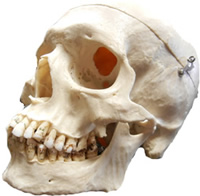Skeletal System - Learning Objectives

1. Identify and describe the functions of the skeletal system.
2. Describe and label the anatomy of a long bone.
3. Distinguish between long bones, short bones, flat bones, and irregular bones and provide an example of each.
4. Identify the parts of a typical long bone.
5. Describe the microscopic structure of compact bone, and compare it with that of spongy bone.
6. Explain the process by which bones are formed and how they growth in length and width.
7. Identify all the bones of the appendicular skeleton on a model and on a real human skeleton with identification of individual structures within those bones
8. Identify the bones of the skull on a real human skull and a model
9. Compare differences between male and female skeletons, and differences between the bones of individuals at different ages
10. Diagnose specific types of bone fractures on X-ray images
11. Describe and diagnose disorders of the skeletal system.
12. Reconstruct a skeleton from disarticulated bones (Lab)
Essential Questions:
- How is the structure of bone related to its function?
- What changes occur in bones as you age?
- How does the skeletal system help the body maintain homeostasis?
- What are the strengths and limitations of the body's joints?
- How do problems with the skeletal system affect the entire body?
NGSS Science Standards
HS-LS1-2 Develop and use a model to illustrate the hierarchical organization of interacting systems that provide specific functions within multicellular organisms
